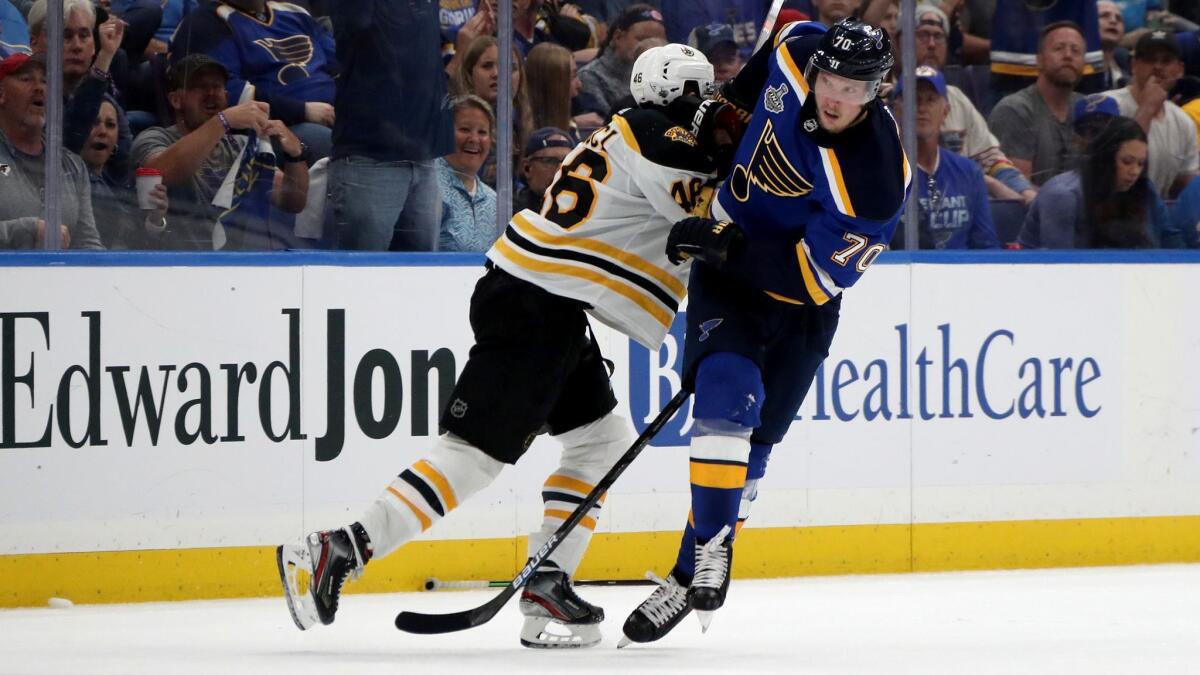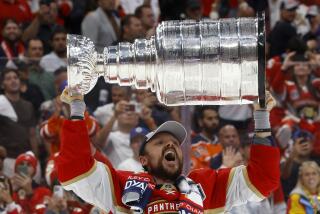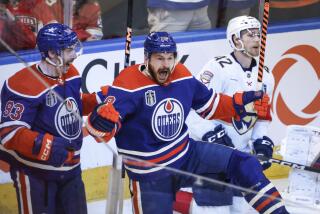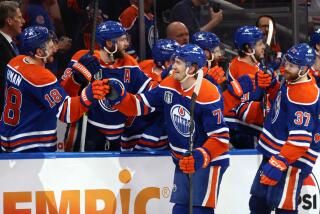Column: Blues and Bruins have delivered plenty of brawn and bruises to Stanley Cup Final

Reporting from boston — The hits keep coming and so do the bruises, black and blue like the predominant uniform colors of the Boston Bruins and the St. Louis Blues. This is hard, big-bang hockey, an unexpected but entertaining detour away from the youth-and-speed-driven game that trended during the regular season.
The fourth game of the Stanley Cup Final was the hardest-hitting yet, with the teams combining for 85 hits in the Blues’ series-tying 4-2 home victory on Monday. It was also the fourth straight game the Blues had the edge in hits.
That’s significant because statisticians who track such things often favor the home team in subjective categories, yet the Blues were credited with more hits than the Bruins in the first two games in Boston, by 33-32 in Game 1 and 50-31 in Game 2.
The Blues are bigger than the Bruins on defense — St. Louis’ smallest defenseman in Game 4 was 6-foot, 208-pound Vince Dunn — and on the left side, and that has taken a toll on the Bruins everywhere on the ice. “We’re a big, heavy team and when we get pucks low we grind it down low and get second and third opportunities. We get rewarded,” Patrick Maroon, a 6-3, 228-pound left wing, said. “We’re just a north-south, simple kind of team.” Simply devastating at times too.
Given their success so far, it’s no surprise that the Blues want to continue to wear down the Bruins as the Final returns to Boston for Game 5, to be played Thursday at TD Garden.
“I think all the series we played have been like that, to be honest with you,” said coach Craig Berube, whose team disposed of the big Winnipeg Jets in six games in the first round, outlasted the Dallas Stars in seven games in the second round, and wore down the wounded San Jose Sharks in six games in the West final.
“That’s kind of, again, how we’re built. We try to play a physical game night in, night out, a forecheck game. We force teams to play 200 feet as much as we can.”
It’s working. The Bruins, who lost puck-moving defenseman Matt Grzelcyk to a head injury in Game 2, played most of Game 4 without team captain Zdeno Chara, who was struck in the face by a shot that deflected off his own stick. Chara, hardly nimble at 42 but still a physical presence, sat on the bench for the final period but didn’t play. Bruins coach Bruce Cassidy said he expected to have more information after Chara consulted a dentist.
If Grzelcyk and Chara can’t play Cassidy said Tuesday he would consider going with seven defensemen by pulling some combination of Steven Kampfer, Jeremy Lauzon or Urho Vaakanainen out of mothballs. Adding newcomers at this late and tense stage seems more likely to weaken the defense than strengthen it. But Cassidy, who has done a fine job strategizing and motivating a team that dealt with major injuries all season, might not have any better options left.
“Personally I think our forwards have to do a way better job with our D out. The onus has to go on them,” Cassidy said. “They have to pull their weight in terms of puck support and helping out the D, finishing some plays.”
They need more five-on-five scoring too. The Bruins have produced six of their 15 goals on the power play and one while shorthanded; center Patrice Bergeron wouldn’t confirm speculation he has been hampered by an injury but he hasn’t been his usual dominant self at both ends. The Blues are merely one for 13 on the power play but this series is tied 2-2.
The Bruins and Blues might start a trend back to heavy hockey, though not every team is capable of playing it as well as they do. Both have dashes of speed in addition to size, and each team has several defensemen who are offensive catalysts. Both teams were built with the playoffs in mind too.
Bruins general manager Don Sweeney did an excellent job in acquiring center Charlie Coyle from Minnesota and winger Marcus Johansson from New Jersey five days later, bringing depth and character. Blues general manager Doug Armstrong, after missing the playoffs last season, took a chance center Ryan O’Reilly would thrive outside the toxic atmosphere in Buffalo. That has paid off dozens of times.
Former NHL goaltender Darren Pang, a broadcaster for Fox Sports Midwest, learned the value of concocting a mixture of size, speed and tenacity while watching the Blues rise from last in the league to the Cup Final.
“The other thing I’ve really learned this year that I didn’t quite understand before is that you can still have slower players and play a fast game,” Pang said. “Like Patty Maroon, when he’s playing his game, he plays fast only because he gets the puck and gives it up. When Alexander Steen holds onto a puck for a long time he likely looks like a slow player, but when he moves it right away and goes to the opening he looks like a fast player.
“And so the same could be said with Tyler Bozak. Ryan O’Reilly is not a fast player but when he’s on his game he plays a give-and-go, fast game.”
Now it’s best of three, each one sure to be black and blue.
Follow Helene Elliott on Twitter @helenenothelen
More to Read
Go beyond the scoreboard
Get the latest on L.A.'s teams in the daily Sports Report newsletter.
You may occasionally receive promotional content from the Los Angeles Times.






